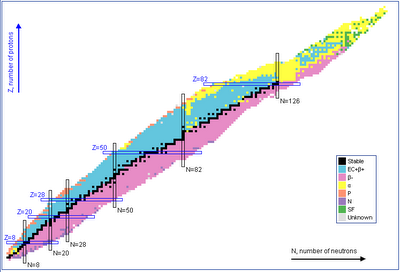Why fuel rods are radioactive
As everyone knows by now, there is a nuclear crisis in Japan. One of the reactors, despite shutting down correctly, has had a number of explosions and has leaked a frightening amount of radioactive material into the surrounding environment. We all know that nuclear reactors produce lots of highly radioactive waste, so hopefully I can clearly explain why.
Every atom has a nucleus, which contains protons and neutrons. The number of protons determines what chemical properties the atom will have, and thus which chemical element it is. Thus, every nucleus with 20 protons is calcium.
In order for the nucleus to be bound together, it must contain roughly equal numbers of protons and neutrons. However, large nuclei need more neutrons than protons.
color coded decay schemes for nuclei
This can be shown in figure 1. This is a chart of the nuclides. The X axis is the number of neutrons, and the Y axis is the number of protons. The little black squares are stable elements. All of the colored squares indicate radioactive nuclei; the color determines the type of radioactive decay.Radioactive decay is a process in which an unstable nucleus changes into a more stable nucleus, releasing energy in the process. The type of energy released depends on the type of decay.
In figure 1, the yellow and green colors, which are most common in the very large nuclei, indicate alpha decay and spontaneous fission. In both of these cases, the nucleus is too big, and breaks into smaller parts. In alpha decay, the nucleus loses two neutrons and two protons. In spontaneous fission, the nucleus splits into two large pieces.
In figure 1, the blue and pink colors are types of radioactive decay where the nucleus has a ratio of neutrons to protons which is either too high or too low. In the blue scheme, one proton turns into a neutron in one of two processes, called “electron capture” and “beta plus” decay. In the pink area, the nucleus has too many neutrons, and one of the neutrons transforms into a proton by a mechanism known as beta decay.
When a neutron (which has no electric charge) turns into a proton (which has a positive electric charge), it also emits a high energy electron (which has a negative charge), so that the total charge does not change. A particle known as an antineutrino is also produced, but this is harmless. However, many beta decays also release additional energy in the form of a gamma ray, which is a photon, or type of light, that is basically the same as a high energy X-ray.
Large stable nuclei have a higher ratio of neutrons to protons than small stable nuclei. Nuclear fission, the process that powers nuclear reactors and bombs, involves splitting a large uranium (or occasionally plutonium) atom in two by hitting it with a neutron. This releases lots of energy, more neutrons, and creates two much smaller nuclei. If one or more of the neutrons created by fission then causes another atom to fission, then the reaction is self-sustaining, or “critical”.

235U fission products, color coded by abundance
Fission is a messy process, so the new nuclei produced are not always the same. Figure 2 shows the probability of various possible fission decay products. purple-red is the most likely, while yellow is less likely. As you can see from figure 2, Most of the nuclei most likely to be produced by fission lie to the right of the stable elements, and this have too many neutrons. This means that they must decay via the beta decay process, turning protons into neutrons (and emitting beta particles and gamma rays) without changing the total mass number, until the resulting nucleus become stable. Note that the distribution field is somewhat dumbbell shaped- there is a heavy purple blob and a light purple blob, with a red connector in between.

Figure 3. Fission decay products in the main heavy area of fission yield. Decay shifts atoms up and to the left.
Figure 3 shows the closeup of the area near the centre of the heavy purple blob. As seen here, the elements that are far from stability generally decay rapidly, but in some cases the last decay to stable can take many years. The result is that even if the fission process is stopped, the radioactive decay in the recently created fission products will continue to heat the fuel in the reactor, leading to all the problems we’ve seen on the news.

No comments:
Post a Comment